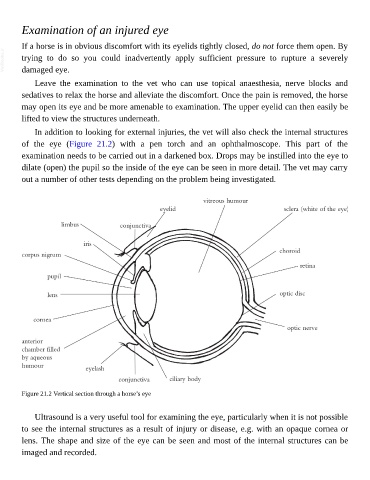Page 977 - The Veterinary Care of the Horse
P. 977
Examination of an injured eye
If a horse is in obvious discomfort with its eyelids tightly closed, do not force them open. By
VetBooks.ir trying to do so you could inadvertently apply sufficient pressure to rupture a severely
damaged eye.
Leave the examination to the vet who can use topical anaesthesia, nerve blocks and
sedatives to relax the horse and alleviate the discomfort. Once the pain is removed, the horse
may open its eye and be more amenable to examination. The upper eyelid can then easily be
lifted to view the structures underneath.
In addition to looking for external injuries, the vet will also check the internal structures
of the eye (Figure 21.2) with a pen torch and an ophthalmoscope. This part of the
examination needs to be carried out in a darkened box. Drops may be instilled into the eye to
dilate (open) the pupil so the inside of the eye can be seen in more detail. The vet may carry
out a number of other tests depending on the problem being investigated.
Figure 21.2 Vertical section through a horse’s eye
Ultrasound is a very useful tool for examining the eye, particularly when it is not possible
to see the internal structures as a result of injury or disease, e.g. with an opaque cornea or
lens. The shape and size of the eye can be seen and most of the internal structures can be
imaged and recorded.

